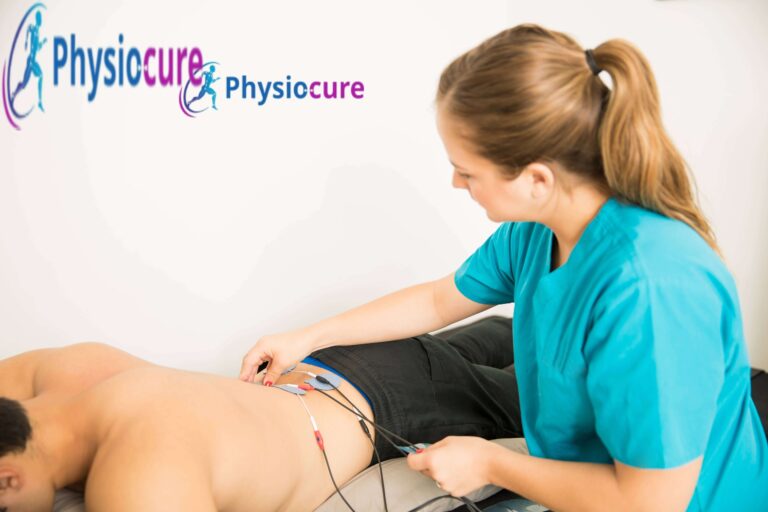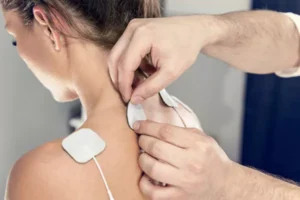What is Interferential Therapy (IFT)?
IFT, which stands for Interferential Therapy, is a sort of electrotherapy used to treat the persisting pain. The theory on which treatment is based works by interfering with two medium frequencies of different values.
For example, if a current in circuit 1 flows at a frequency of 3000 Hz and a current in circuit 2 flows at a frequency of 2800 Hz, the low frequency produced is 20 Hz, which is particularly effective in pain modulation.
The difference in frequencies between the two medium frequency currents created in the tissues at the point where the two currents cross generates a new low-frequency current known as the beat frequency.
What Conditions Can Be Treated With The Help of Interferential Therapy?
As an approach for the pain management when compared to previous stimulation therapies, IFT is a totally distinct technique. The primary therapeutic applications for which IFT appears to be employed are as follows:
- Pain relief in ailments such as causalgia, herpes zoster, and neuralgia.
- Cervical spondylosis.
- Osteoarthritis of the knee.
- Ankylosing spondylitis
- Rheumatoid arthritis.
- Frozen shoulder.
- Disc herniation.
- Spinal canal stenosis
- Muscle Stimulation – avoid muscle waste, re-education, and maintain range of motion
- Reduction of inflammation (Condition in which access water gets collected in muscles and cavities.
- Muscle injuries
- Ligamentous injuries
What Are The Types of Interferential Therapy?
Vector effect – The interference field is spun by 450 degrees in each direction to cover a larger region. This is effective in cases of the disease which spreads very rapidly or when the location of the lesion cannot be pinpointed precisely.
Frequency swings – Some technology allows us to make changes in the rate of the frequency swing. In a rhythmic mode a continuous swing can be observed from 0 to 100 Hz in 5-10 seconds and back in the same amount of time, or it can hold for 1-6 seconds at one frequency followed by 1-6 seconds at another frequency with a variable duration between the two.
Constant frequency – Some therapies can be performed with the interference set to a specific frequency. When treating many types of tissues at the same time, rhythmic frequency comes in handy. A change in frequency also addresses the problem of tissue accommodation, which occurs when the sensitivity of certain cells and tissues decreases with time.
Frequency Sweep – The sweep works on the basis that the machine is designed to automatically alter the stimulation frequency, and it can employ either pre-set or user-defined sweep ranges. The sweep range should be selected to provide the required physiological effects.
The sweep pattern has a considerable impact on the stimulation experienced by the patient. Most machines have many sweep patterns to choose from:
Triangular sweep pattern.
Rectangular Sweep Pattern.
Trapezoidal Sweep Pattern.
What Are The Characteristics of Interferential Therapy?
Amplitude modulated frequency(AMF) – Amplitude Modified Frequency refers to the frequency at which the amplitude of current is modulated (AMF). The resultant current created by the intersection of the two carriers has its amplitude modulated at the frequency that is the difference between the two carrier frequencies in interferential current.
Beat Frequency – The beat frequency is the frequency of the resulting current. the difference between two medium frequency currents is equal to the beat frequency. To avoid accommodation, it might be maintained constant or altered rhythmically. The selected beat frequency is another name for constant beat frequency.
Area of Interference –
Static Interference – The region where the interferential current is established remains stationary. As a result of the vector addition of two currents, this area of static interference resembles a clove leaf and is located at 45o angles to the perpendicular lines from each electrode.
Dynamic interference – It is possible to rotate the area where the interference current is generated via 45o. It is accomplished by adjusting the current intensity appropriately. This dynamic interference region is also known as a vector sweep, vector scan, revolving vector, and so on. Vector scans in 45, 90, and 360° C are provided.
Base –
This indicates the beginning point of the waveform or frequency from the neutral level; for example, if the base is set at 10 Hz, the waveform or frequency cycle begins at 10 Hz, reaches the desired peak, and then descends. It now maintains a constant current flow or a break before returning to the 10 Hz zone to complete the next consecutive cycle.
Spectrum-
This defines the needed peak level reach of the waveform or the frequency range from the base, i.e. if the spectrum is set at 60 Hz and the base is 10 Hz, the cycle begins at 10 Hz, travels to the maximum peak level of 60 Hz, and then returns to the base. The utilisation of spectrum has the benefit of preventing tissue adaptation to a specific frequency and the accommodation property. As a result, the prescribed therapy can be conducted for a longer period of time and repeated more frequently.
Sweep-
This represents the flow of frequency from a current lowest level to the highest level, as determined by base and spectrum, i.e., if the user requires a frequency sweep between 10 and 60 Hz, the base level is present at 10 Hz and the spectrum level is present at 50 Hz, where the frequency sweep is 10 to 60 Hz. The benefit of this is that depending on the stage of the patient’s illness, the wave type and the accommodation characteristic of the tissues may be varied.
Balance-
The amount of electric current applied on the skin is determined by the electrode, sponge, and skin conditions. As a result, when the two currents are applied, the differential resistance opposed may result in unequal current going through each circuit. To compensate for this, the current in both channels may be equalized using this balancing.
What Are The Treatment Parameters of IFT?
The interferential therapy depends on the following factors –
- Frequency
- Intensity of current
- Electrode placement




